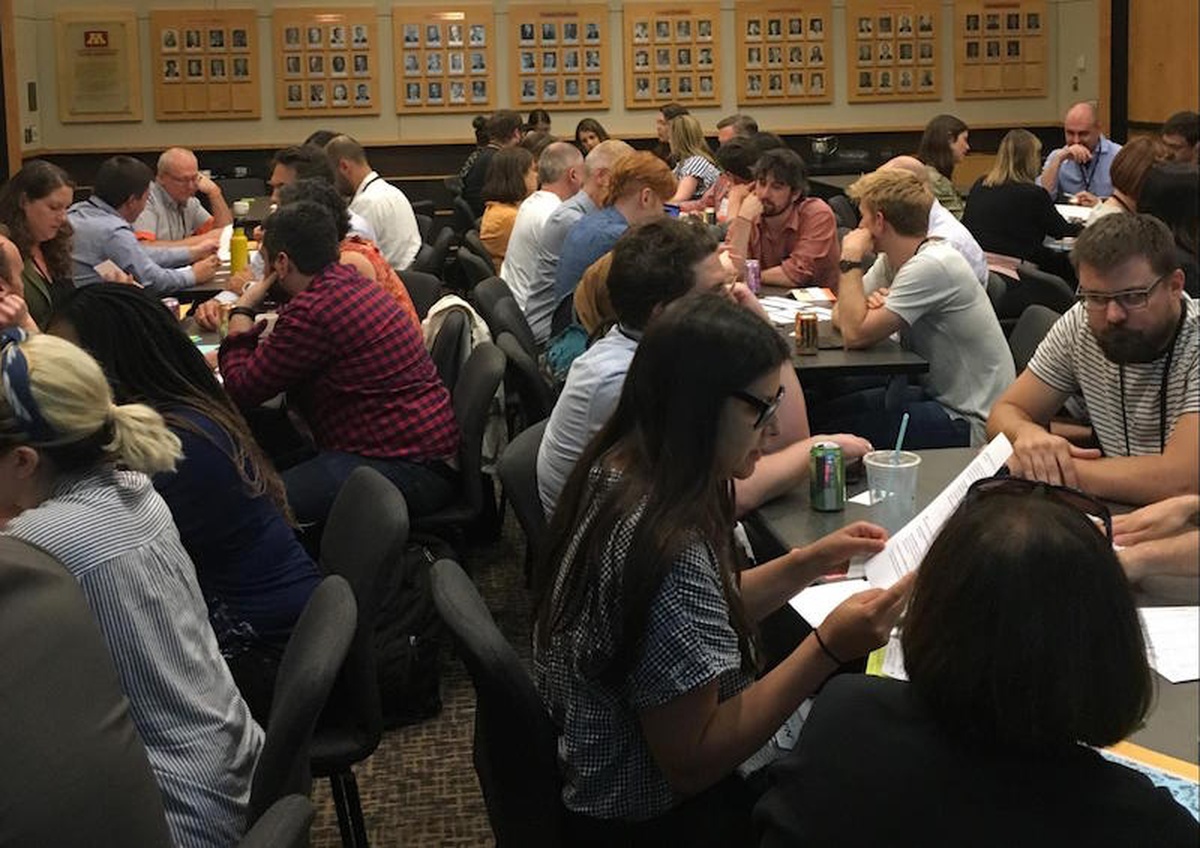Features:
How We Built (and Nurtured) a Newsroom Product Team
Lessons from changing minds and shifting processes to be more product-oriented at Chemical & Engineering News

Participants working on a product-focused exercise that we led at SRCCON 2019. (Jessica Morrison)
When we started thinking about bringing a product mindset to Chemical & Engineering News, we were looking for a way to maintain the quality journalism our readers expect as our ambitions grew. But our resources weren’t growing in step with our ambitions, so we started to build infrastructure that would support our work, processes that would scale, and strategies that would help us respond quickly to change.
Eighteen months later, we have a product team and processes that allow us to receive and prioritize product requests that would’ve previously sent us into chaos. In this short time, we’ve also become a model for agility and change management within our newsroom and our larger parent organization, the American Chemical Society.
Like others in the news industry, we’ve been working to define what product means in our newsroom, and we recently shared that work at SRCCON 2019. At C&EN, we’ve defined product as all of our content types, our brands, and our distribution channels: our weekly print magazine, our website, our digital magazine, our podcast, our voice skill, our ad types, and our internal platforms. We’ve taken an experimental, agile approach to product and process at C&EN, and that extends to the creation of our product team, too.
Our product team is composed of team members from each of our six core newsroom business units: editorial, creative, engineering, revenue, product, and operations. The 13-member team, which includes the leaders of each of the business units as contributing stakeholders, is responsible for product strategy, product research, and product development. Since October 2018 we’ve been working in two-week sprints, and our team has already made major contributions to storytelling, platform, ad tech, and AI projects.
An important part of building and nurturing an agile product team is making it a priority to maintain and improve the team in the same way you would an existing, beloved product. Here are a few things we’ve learned:
Kick it off right.
We learned about Kickoff Kit at SRCCON 2018, and we used it to get our team from forming to performing fast. One of the exercises from Kickoff Kit, “Hopes, Fears, and Non-Negotiables,” helped us dive into the feelings that everyone on the team was having about trying out a new way of working together. Through our non-negotiables, we documented things like “courage to surface problems,” “we will iterate,” and “respectful communication,” so that we could remind ourselves later what’s important and hold each other accountable.
Align your stakeholders.
We didn’t intend to break silos when we created our product team, but that’s what happened. When you bring a group of people, who represent every business unit in your organization, together every week to talk about and prioritize projects and other work to be done, the walls start to come down. Want to take a closer look at our processes? Here’s our product team documentation.
Run a good meeting.
That doesn’t mean it was easy. First of all, it can be hard to get a group of people, many of them director level, to agree to another recurring meeting. But once everyone began to see that our meetings were well-organized and productive and that the process could help us get things done faster and with less chaos, they showed up. And they kept showing up. We’ve been working in sprints now for just over 9 months.
Find ways to share ownership.
Speaking of running good meetings, we take turns. From the very beginning, we baked in this idea that everyone should be able to run a sprint meeting, and everyone should be able to take notes. We didn’t want these responsibilities to fall only to the people who are “best at” running meetings and taking notes. A bonus effect of sharing ownership of the process: If someone goes on vacation, the work keeps moving.
Celebrate wins widely.
Some product team work is highly visible, but a lot of it happens in the background to keep our newsroom running smoothly. We’re still optimizing how we make all product work visible to the rest of our newsroom—as with any large cultural shift, it’s going to take time. We’ve started by adding product updates to our monthly C&EN-wide planning meetings, and we’ll be rolling out quarterly memos at the end of Q3.

A glimpse of a Kickoff Kit-inspired exercise called “Hopes, Fears, and Non-Negotiables.” (Taylor Hood)
Organizations
Credits
-
 Jessica Morrison
Jessica Morrison
Jessica Morrison manages product development and user research for Chemical & Engineering News. She lives in Nashville, Tennessee, with her husband Brandon and their two cats, Gypsum and Drupal.
-
 Amanda Yarnell
Amanda Yarnell
Amanda Yarnell is the Senior Director of Harvard T.H. Chan School of Public Health’s Center for Health Communication. The center defines, teaches, and shares best practice for credibly communicating health information in an increasingly fragmented world. Prior to joining Harvard Chan, Amanda led the editorial, product, and audience engagement teams at Chemical & Engineering News, an award-winning nonprofit science news outlet published by the American Chemical Society. She also serves on the advisory board of Drug Hunter, a platform that empowers, educates, and connects scientists who work in drug discovery.



